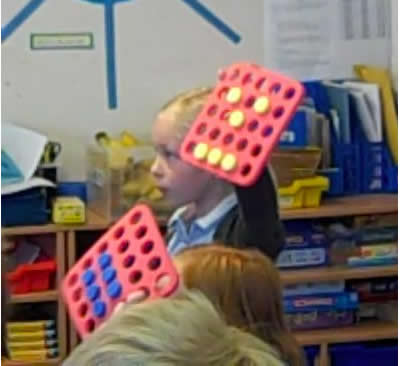Or search by topic
Number and algebra
Geometry and measure
Probability and statistics
Working mathematically
Advanced mathematics
For younger learners
Poly Plug Rectangles



- Problem
- Getting Started
- Student Solutions
- Teachers' Resources
Poly Plug Rectangles
This activity has been inspired by Doug Williams' Poly Plug resource. You can find out more details, including how to order sets of Poly Plug, on the Mathematics Centre website. However, you do not need sets of Poly Plug to have a go at this activity - please see below and take a look at the Teachers' Notes.
In this activity, the monkey secretly makes a rectangle using equal rows of spots on the $5$ by $5$ grid.
The aim is for you to find the rectangle by testing spots on the interactivity below.
Once you think you know where the monkey's rectangle is, click the 'Ready' button.
Which spot is a good one to test first? Why?
If you had to use as few test spots as possible, how would that change the way you play?
Are there some total numbers of spots that are easier than others?
We would love to hear about the strategies you use for finding the monkey's rectangle.
You may be interested in the other problems in our Jaunts into Geometry Feature.
This problem featured in an NRICH video in June 2020.
Why do this problem?
Possible approach
Key questions
Possible extension
Learners could play a version of the game in pairs which allows diagonal rectangles too.
Possible support
Annotated videos
Clip 1 (above): We gave the children some time to play with the Poly Plugs as these were new to them. Not all used them to make patterns within the grid but almost everything was mathematical! There was a lot of noise, most of it productive, and our feeling was that if we hadn't given them this time, they would not have been so focused later on.
 Picture 2: Having given them time to play freely, we then suggested they make any pattern or picture they like using just six plugs. We used this child's pattern to draw out the properties of a rectangle.
Picture 2: Having given them time to play freely, we then suggested they make any pattern or picture they like using just six plugs. We used this child's pattern to draw out the properties of a rectangle.
Clip 3 (above): We then introduced the class to the interactivity. (The interactiivty has since been updated so looks a little different now.) We made the mistake of using a rectangle of four plugs, rather than building on the work they'd just done using six plugs to make a rectangle. You can see the difference in their reactions in this clip and clip 4 which does use six plugs. We re-wrote these teachers' notes after this experience.
Clip 4 (above): In this clip, we encourage the children to find the rectangle more quickly and this time it contains six plugs.
Clip 5(above): We were keen that the children should share their thinking. It was interesting, but unsurprising, that they were disappointed when a plug turned blue.
Clip 6 (above): In this clip, we confronted their keenness to choose only positive examples, trying to help them to see that a blue plug could give them far more information than a yellow one. We're not sure we won though!
Related Collections
You may also like
Consecutive Numbers
An investigation involving adding and subtracting sets of consecutive numbers. Lots to find out, lots to explore.
Roll These Dice
Roll two red dice and a green dice. Add the two numbers on the red dice and take away the number on the green. What are all the different possible answers?

